Syn.: Abies menziesii Mirb., Pseudotsuga douglasii (Sab.) Carr., Pseudotsuga taxifolia (Lamb.) Britt.
Family: Pinaceae Lindl.
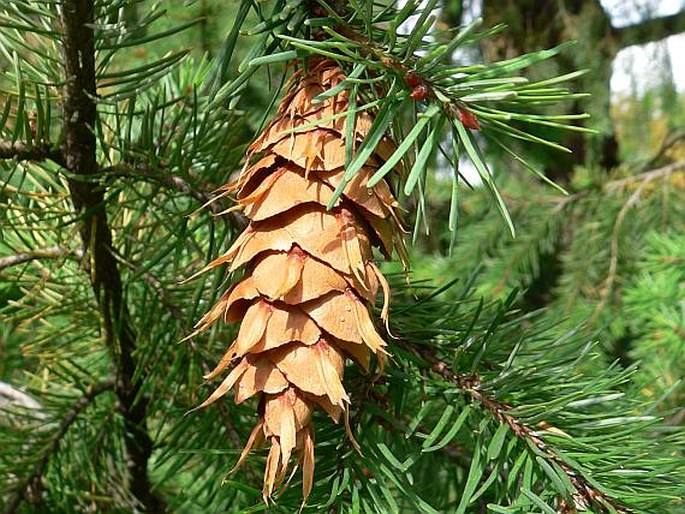
Distribution: Coastal area of western part of Northern America – northern part of USA and southwestern part of Canada. Northern border reaches on the Vancouver Island 52° northern altitude (in Canadian British Columbia), area continues southward about 2200 km along the Pacific coast line to the California (area of the Yosemite National Park). Eastern distribution border is approximately formed by the mountain ridges of Cascade Range and Sierra Nevada. Vertical distribution is between 0–2300 metres above the sea level. First Douglas-fir in Europe was planted in 1842 in Czechia (Chudenice town).
Ecology: It grows in the areas with seaside climate, with mild, wet winter and cold relatively dry summer, with small temperature variation and short frost period. Precipitations are concentrated on winter months. In Cascade Range is climate a bit more inclement. This species is firstly quite tolerant to the shading, when growing up is middle light-intensive. Douglas-fir likes deep, clayey, nutrition well-stocked, pervious and well aerated soils with pH 5–6.
Supporting woody species on Pacific north-west are Thuja plicata, Tsuga heterophylla, Picea sitchensis, Abies grandis, Abies procera, Quercus garryana, Alnus rubra. In the Sierra Nevada Mountains grows mainly with Abies concolor and Pinus ponderosa, in coastal part of California mainly with Sequioa sempervirens and Lithocarpus densiflorus. In areas with frequent catastrophic fires forms also pure unmixed forest to the prejudice of the other woody species. Strong rhytidome at the bottom the older trunks and on the tap-root and also the ability to forms adventitious roots are the main factors, that makes possible to live after the woody species, that are worse fitted against the fire. Douglas-fir would be basically in natural area gradually replaced by more shading-tolerant woody species without fire.
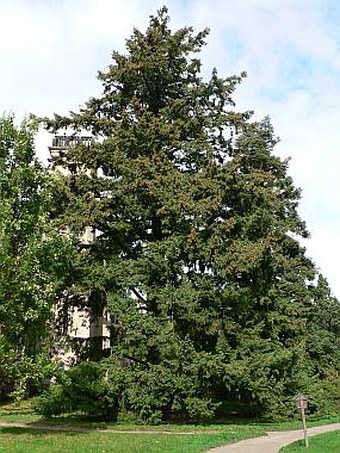
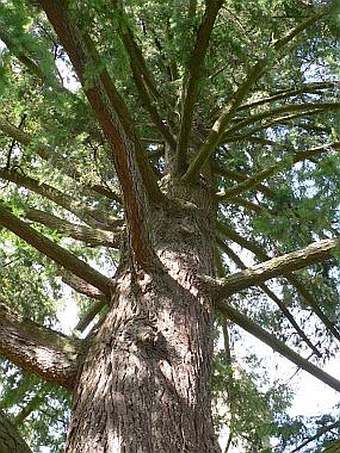
Description: Coniferous tree, 55–100 m tall and 1–3 m in diameter. Treetop is firstly conical, then – in old age – is rounded, irregularly flattened on the top. The trunk is long, cylindrical, in the elderly trees naturally pruned. Rhytidome in the younger trees is smooth with resinous postulate, in the older trees corky, strongly furrowed in strong oblong red-brown ridges, separated with deep cracks. Bark thickness could reach 15–30 cm and more. Annual shoots are yellow to brown, with straggling short hairs or bald. Buds are glossy, chestnut-brown, slightly resinous, with typical fusiform sharpened shape. Needles on twigs are spiral ordered, glossy green, 15–35 mm long, on the upper side with lengthwise groove, underneath with 2 strings of whity spiracle lines. Needle basis, contrary to firs, is constricted in a short footstalk. Rubbed needles have citrus balsamic fragrance. Needles hold on the branches up to 5–8 years. Male strobile is oblong, cylindrical, 12–23 mm long, orange-yellow, female strobile is conical, green or purple. Cones are not fragmenting, brown, shortly pedunculated, hanging underneath, 5–10 cm long, about 3 cm wide. Seedy scales are rounded, hole margined, about 2 cm wide. Marked, not recurvate supported tricuspid scales, that protrudes out of the cone. Seeds are triangular, about 7 mm long, winged. Cones matured at the end of their first vegetation season. The lifespan is 500–1000 years.
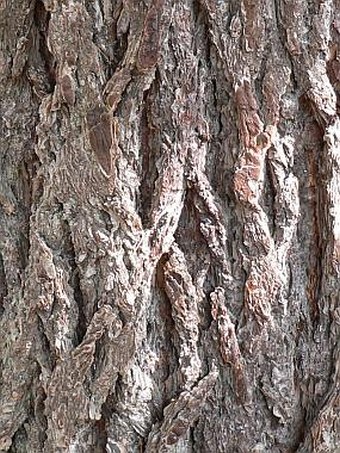
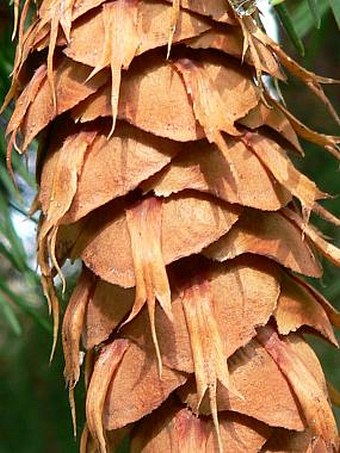
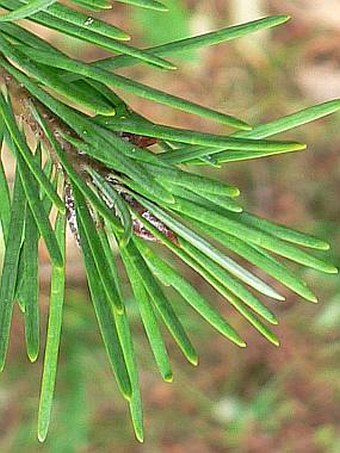
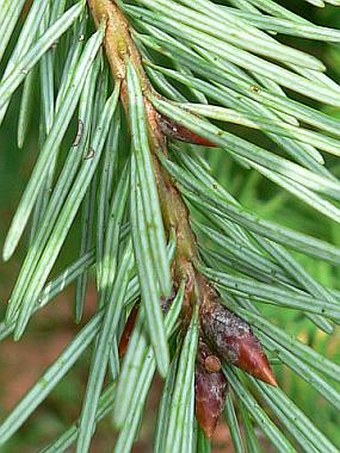
Use: It is one of the most considerable North American coniferous trees that produce one of the most useful woods. It is the highest American species after sequoia and is called “Forest Monarch of the Pacific North-west”. It is the state woody species of Oregon (USA). Wood is resinous, high-quality, with sapwood to 5 cm wide and with yellowish duramen that is roughly fibrous, or reddish, gently venous. Used for different purposes, mainly as building and constructional timber, is suitable also for bridgework, telegraph poles and railway sleepers, window frames, paper etc. It is planted also on the plantation with Christmas trees in rotation of 4–7 years. It is necessarily to curtail the buds because of reaching the desired shape.
American aborigines used except wood that was instrumental to house building, tools producing, served as firewood. They used also the resin as a sealing and connecting material and to produce ointments supporting wounds healing. Especially popular was this wood by the Polynesia inhabitants, mainly aborigines of the Hawaii Islands, which imported by wood floating the trunks of Douglas-firs and than built war canoe of them. They used this wood also to a produce harpoons, spears but also useful things in their household.
Note: Douglas-fir was very successfully introduced in many forest areas of temperate zone. In the forests of Middle and Western Europe is Douglas-fir the most often planted and best tested foreign coniferous tree.
It is also used in Europe as an important solitaire park woody species.
Records of the species: Probably the highest tree in Europe is presently over the 65 m tall Douglas-fir growing in the Great Britain. The highest tree of Germany is also 60 m tall Douglas-fir growing near Ebersbach am Neckar.
The highest Douglas-fir is 100.5 m tall and grows in E. Fork Brummit Creek in Coos County in Oregon (USA).
The maximum volume: 350 m3 (height 74 m, 423 cm in diameter) Red Creek Fir on the Vancouver Island (British Columbia, Canada).
The highest Douglas fir wrote in literature should have reach 117.3–120.4 m and 4.6 m in diameter. They grew in the beginning of 20th century near Mineral in Washington (USA), the oldest felled tree in this area reached reputedly 1400 years.
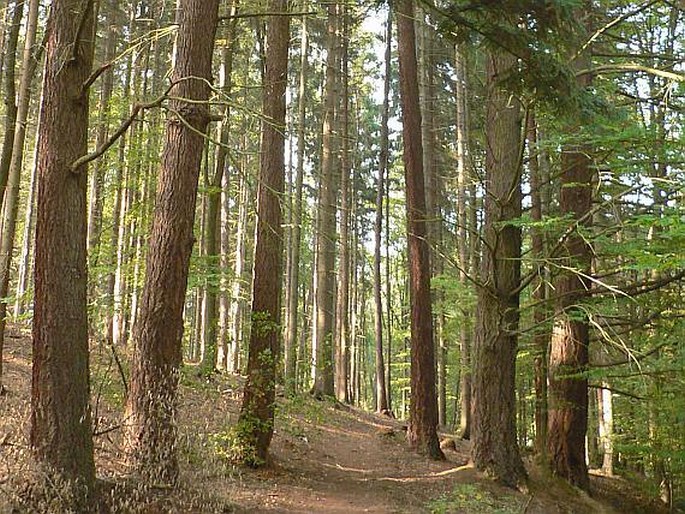
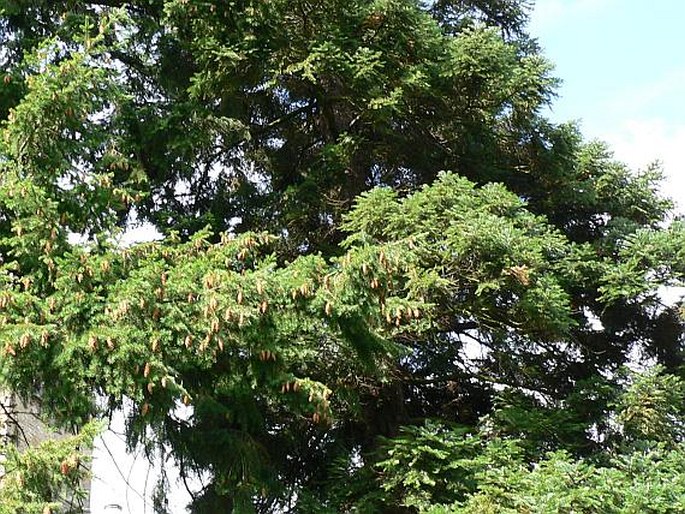
These images were taken in Czechia, Bohemia, Sychrov Park (September 2006).
Translation: Lucie Hodačová


